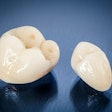
Many preschool-age children develop new caries regardless of fluoride varnish treatments, according to a new study. The researchers concluded that further cost-savings analysis is needed to determine if this treatment should be abandoned.
Both U.S. and European pediatric dentistry associations widely recommend the application of fluoride varnishes for their assumed anticavity benefits in children, though many children get fluoride from water supplies and toothpaste.
Co-author Ana Paula Pires dos Santos, DDS, PhD, from Brazil and colleagues performed a systematic review of clinical trials of fluoride varnishes when used alone or as part of oral health programs, compared with usual care and no dental intervention. The results were published June 20 in Caries Research.
The study aimed to assess the effectiveness of fluoride varnish therapy in reducing the risk of developing new cavities and tooth decay-related hospitalizations in preschool-age children. The group analyzed 20 relevant past studies concerning the use of fluoride varnish. More than 13,650 children between the ages of 24 months and 5 years were included.
Using the indexes decayed, missing, and filled teeth (dmft) and decayed, missing, and filled surfaces (dmfs), the researchers measured the number of primary teeth and tooth surfaces that developed new dentine caries lesions.
They found that fluoride varnish resulted in caries on one fewer tooth surface per child who received the treatment. At the tooth level, they found no significant difference between children who received fluoride varnish and those who did not.
At the individual level, the analysis showed that the risk of developing new caries lesions was reduced by 12% among the children who received fluoride varnish, compared with those who did not.
Furthermore, the researchers found that in a population of preschool children with 50% caries incidence, fluoride varnish must be applied in 17 children to avoid new caries in one child.
The review showed that the effectiveness of fluoride varnish was lower in more recent clinical trials than in older ones. This might be due to higher risks of bias, specifically selection bias, which can inflate treatment effects, according to the researchers.
"Despite the uncertainty around the size of the effect estimates and the small effect size, [fluoride varnish] could still be a cost-effective alternative in certain circumstances," concluded Dr. dos Santos, from the Rio de Janeiro State University School of Dentistry, and colleagues.



















